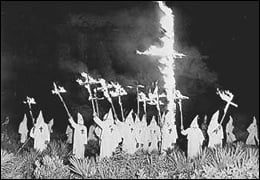 It was a gruesome and hateful
crime—three men with white supremacist tattoos punching and kicking the face
and body of an African-American man at a bus stop in Houston last summer simply
because of the color of his skin. All three were recently convicted of the
attack, following an investigation by the FBI and its partners.
It was a gruesome and hateful
crime—three men with white supremacist tattoos punching and kicking the face
and body of an African-American man at a bus stop in Houston last summer simply
because of the color of his skin. All three were recently convicted of the
attack, following an investigation by the FBI and its partners.
It’s not an isolated case. It seems like
a throwback to a different era, but white supremacy—which sees whites as
inherently superior to those of other races—still exists in America today.
Having those kinds of beliefs is not against the law…as a matter of fact, it’s
protected by the First Amendment. But white supremacy becomes a crime—and for
the FBI, a form of what we call extremism—when it is furthered through
threatened or actual use of force or violence or other illegal activity.
The Bureau has been investigating the
criminal activities of white supremacy extremists like Ku Klux Klan members
since as early as 1918. Today’s extremists are more challenging than ever.
They’re affiliated with a variety of white supremacy groups, and they can be
motivated by any number of religious or political ideologies. We’re also seeing
more lone offenders and small, violent factions of larger groups at work, which
makes detection of these crimes tougher.
White supremacy extremists specifically
target racial, ethnic, and religious minorities; the federal government; and in
some instances, even each other. Their tactics include assault, murder, threats
and intimidation, and bombings. They also commit other kinds of crimes—like
drug trafficking, bank and armored car robberies, and counterfeiting—to fund
their hate-filled activities.
Over the years, the federal government
has successfully charged white supremacy extremists using a number of federal
statutes, including civil rights violations, racketeering, solicitation to
commit crimes of violence, firearms violations, explosives violations,
counterfeiting and forgery, and witness tampering.
 In recent months, the FBI has led or
participated in a number of significant investigations involving violence or
attempted violence by self-admitted white supremacists. A few examples:
In recent months, the FBI has led or
participated in a number of significant investigations involving violence or
attempted violence by self-admitted white supremacists. A few examples:
■In February 2012, an Arizona man was
sentenced to federal prison after pleading guilty to possessing and
transporting improvised explosive devices near the U.S.-Mexico border.
■In January 2012, the last of four
Arkansas defendants charged with firebombing the home of an interracial couple
was sentenced to federal prison.
■In December 2011, a Washington man was
sentenced to 32 years in prison for attempting to bomb a Martin Luther King,
Jr. Unity Day march in Spokane.
■In May 2010, an Oregon man pled guilty
to mailing a hangman’s noose to the home of the president of a local NAACP
chapter in Ohio.
Moving forward, we see three keys to
turning back the ongoing scourge of white supremacy extremism:
■Our increased emphasis on the lawful
gathering, analyzing, and sharing of intelligence on current and emerging
trends, tactics, and threats.
■Continued collaboration with our local,
state, tribal, and federal partners, especially on our Joint Terrorism Task
Forces around the nation.
■And most importantly, the support of
Americans who find these types of crimes abhorrent and antithetical to our way
of life.
If you have information on domestic
terror threats of any kind, submit a tip or contact your local FBI field
office.






No comments:
Post a Comment